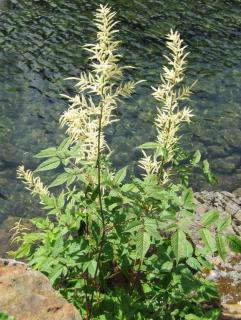

Goat’s beard, Aruncus dioicus, is a very showy plant that grows up to 6 feet / 1.5 meters tall, forming large bushy clumps.
Name – Goat’s beard, Aruncus dioicus
Family – Rosaceae
Type – perennial
Height – 3 to 6 feet (1 to 1.5 meters)
Exposure – well-lit
Soil – moist, acidic
Foliage: deciduous
Flowering: end of spring, beginning of summer
The species is now naturalized across the entire temperate Northern Hemisphere. This means planting Aruncus dioicus is easy in our whereabouts! Butterflies are very much attracted to the many white flowers. Flowers, which are also great as cut flowers in a vase, stay magnificent for about 10 days.
The long, showy plumes of tiny white goat’s beard flowers are similar to those of Astilbe. Since it’s a dioecious plant, each plant is either male or female. The flower panicles are 6 to 38 inches long and the plant as a whole never grows much taller than 5-6 feet (150-180 cm). They’re quite massive! Male specimens have the most impressive flowers.
The species as a whole, Aruncus dioicus, requires moisture, proper sunlight and rich, rather acidic soil (not limestone). Goatsbeard tolerates seasonal flooding. It needs a lot of space. As a result, you’ll only be able to grow it outside.
 Plant either a single plant or a cluster of several along a stream or in a water garden.
Plant either a single plant or a cluster of several along a stream or in a water garden.Clearly, this is a plant to use for landscaping for its incredible white inflorescence in spring and summer. For instance, plant a few goats beard as irregular clusters along a slope. Indeed, these taller plants make for a great backdrop, behind shorter flowers. In particular, the shaded and wetter areas around forest clearings or in a shrub bed.
Note that it’s impossible to determine whether a plant is male or female upon purchase.

Eliminating spent flower scapes won’t trigger new blooming, but it will make the plant look nicer. Simply chop up the wilted stems and spread them on the ground: this can help retain water in the soil to maintain high moisture levels.
For female plants, however, you might prefer to keep the flower stems on the plant, without cutting them: they turn into beautiful plumes of seeds as they dry out.
Info: as long as soil moisture is constant, goat’s beard will do great even in full sun in climates where it doesn’t get too hot. In warmer climates, part shade is better.

Reminder: since each plant is either male or female, you’ll need to have at least one of each to get fertile seeds. Harvest the seeds about one month after the blooming, from the female plants. To sum it up, it’s almost impossible to collect perfectly viable seeds!

The occasional caterpillar might feed on its leaves.
The Aruncus genus, from the Greek word aryngos , literally means “beard of the goat”. It refers to the showy flower clusters that look like fingers, forming feather masses with all the male and female flowers.
In western countries, another species was included. Its name was Aruncus sylvestris, among other names. There are four natural varieties, three of them are native to North America. Aruncus dioicus var. vulgaris is native to western and central Europe, Russia, and the Caucasian mountains. However, some botanists dispute this and consider that plants in the west are of the pubescens variety, while others vouch that it is acuminatus instead.
False goat’s beard Astilbe biternata looks very similar. However, it belongs to the saxifrage family. Also, a key difference with Aruncus dioicus is that each leaf has a lobed, terminal leaflet at the tip, and two pistils.
Native Americans used goat’s beard for medicine. For instance, they’d prepare poultices from the roots to heal wounds. Root infusions were used to treat a few different ailments, like rheumatism, sore throat, fever and blood diseases.